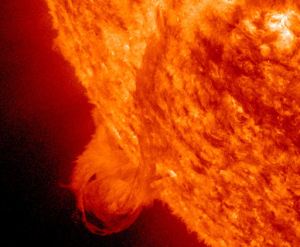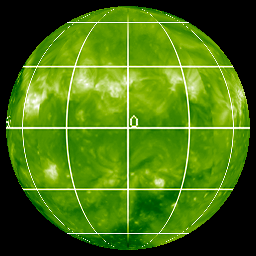SUN’S-A-POPPIN’ AND POINTIN’ OUR WAY
Newly arriving data from NASA’s STEREO probes suggest that a coronal mass ejection (CME) might be heading toward Earth. The source of the cloud appears to be sunspot complex 1185-1186, which experienced an episode of magnetic instability during the early hours of April 9th and again on the 10th.
Since April 7th the active region has hurled massive clouds into space. High latitude sky watchers should be alert for auroras. NOAA forecasters estimate a 40% chance of geomagnetic activity during the next 48 hours, when a solar wind stream is expected to buffet Earth’s magnetic field.
This movie to the right shows a spherical map of the Sun as it currently appears, formed from a combination of the latest STEREO Ahead and Behind beacon images, along with an SDO/AIA image in between. The movie starts with the view of the Sun as seen from Earth, with the 0 degree meridian line in the middle. The map then rotates through 360 degrees to show the part of the Sun not visible from Earth.
 STEREO consists of two space-based observatories – one ahead of Earth in its orbit, the other trailing behind. With this new pair of viewpoints, scientists are able to see the structure and evolution of solar storms as they blast from the Sun and move out through space.
STEREO consists of two space-based observatories – one ahead of Earth in its orbit, the other trailing behind. With this new pair of viewpoints, scientists are able to see the structure and evolution of solar storms as they blast from the Sun and move out through space.
There are two kinds of solar storms, often related to each other: coronal mass ejections (CMEs) and solar flares.
A flare occurs when magnetic energy builds to a peak near the Sun’s surface and explodes. This intense, fast-paced event results in an intense burst of light, including X-rays, in the Sun’s lower atmosphere.
A much larger storm, a CME erupts when magnetic field lines snap, sending billions of tons of material into space at millions of miles per hour. The cloud expands to over 30 million miles by the time it reaches Earth. Both flares and CMEs can result in additional high speed particles being shot out into the solar system at close to the speed of light.

A side-by-side comparison of the Sun from precisely two years ago (left, from SOHO) to the present (right, from Solar Dynamics Observatory) dramatically illustrates just how active the Sun has become. Viewed in two similar wavelengths of extreme ultraviolet light, the Sun now sports numerous active regions that appear as lighter areas that are capable of producing solar storms. Two years ago the Sun was in a very quiet period (solar minimum). The Sun’s maximum period of activity is predicted to be around 2013, so we still have quite a ways to go.
Click here to see the a composite of latest NASA LASCO C2 coronal images. Covering April 4-10, the GIF animation shows an amazing display of CME activity starting on April 7. This is a large file but worth downloading.
When the ejection is directed towards the Earth and reaches it as an interplanetary CME (ICME), the shock wave of the traveling mass of solar energetic particles causes a geomagnetic storm that may disrupt the Earth’s magnetosphere, compressing it on the day side and extending the night-side magnetic tail. When the magnetosphere reconnects on the night side, it releases power on the order of terawatt scale, which is directed back toward the Earth’s upper atmosphere.
This process can cause particularly strong auroras in large regions around Earth’s magnetic poles. These are also known as the Northern Lights (aurora borealis) in the northern hemisphere, and the Southern Lights (aurora australis) in the southern hemisphere. Aurora appear from Earth as shimmering, dancing lights in the night sky. Although green is the most common color, red and yellow hues are also observed.

A coronal mass ejection observed April 10 by the SOHO spacecraft heralds the approach of an active region to the Earthside of the sun. The source of the blast is currently located behind the sun’s northeastern limb, but solar rotation will turn it in our direction in the days ahead.
Coronal mass ejections, along with solar flares of other origin, can disrupt radio transmissions and cause damage to satellites and electrical transmission line facilities, resulting in potentially massive and long-lasting power outages.
Humans in space or at high altitudes, for example, in airplanes, risk exposure to intense radiation. Short-term damage might include skin irritation. Long-term consequences might include an increased risk of developing skin cancer.
More information:
NOAA Space Weather Prediction Center
The Very Latest SOHO Satellite Images
Regional Warning Center Sweden of International Space Environment Service
No comments yet.


Leave a comment